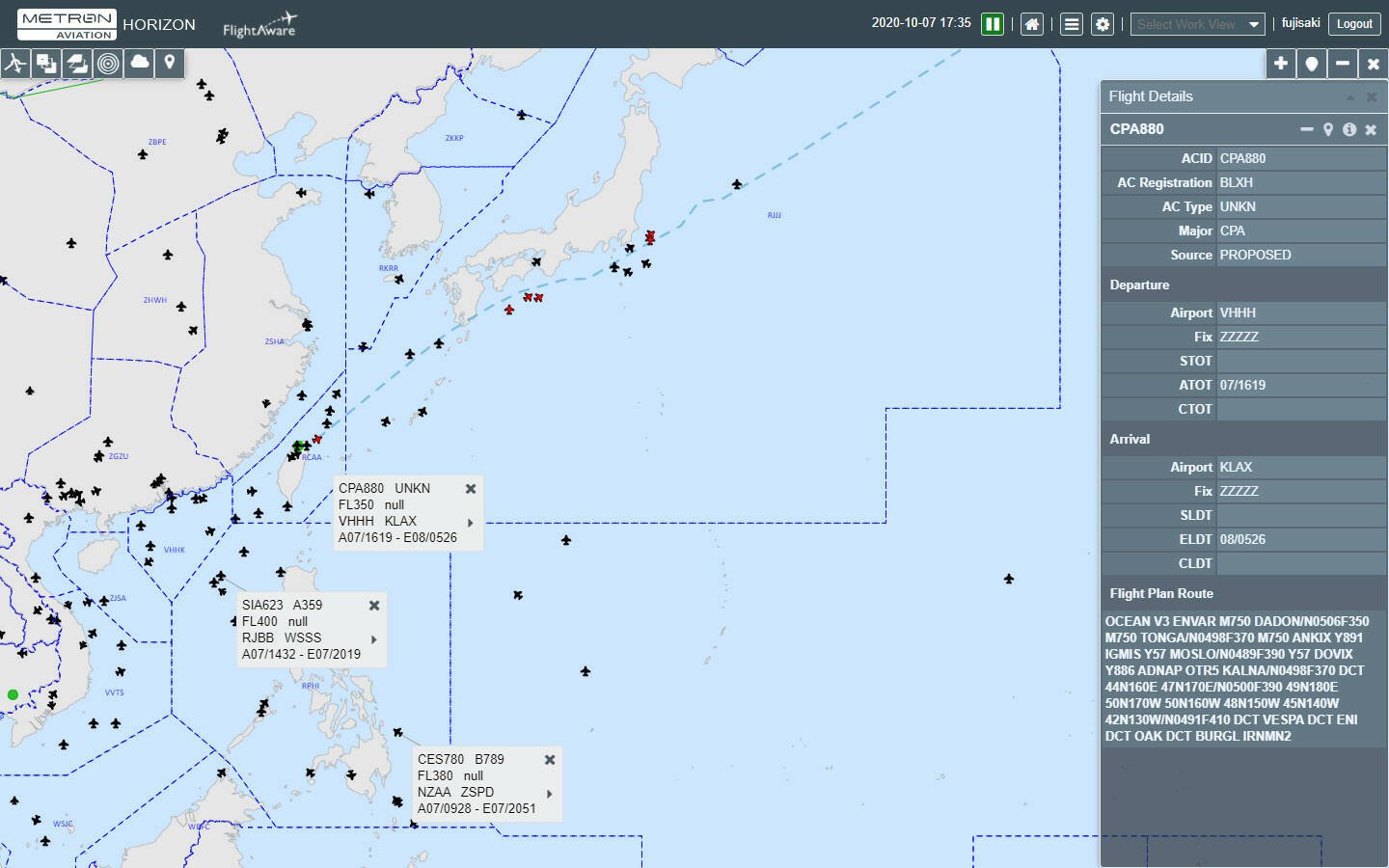


Dr. Robert Hoffman, Vice President, Advanced Research & Engineering Services, Metron Aviation, Inc., believes there is no better time to prepare for the future.

Aviation economists suggest that it may take years for the aviation industry to recover from the impact of the COVID-19 pandemic. The unprecedented nature of this scenario leaves us without reliable models to predict the rate of recovery for the industry. Despite this, there are technologies available to help air navigation service providers (ANSPs) manage uncertainties in a COVID-19 world.

Utilising technology
COVID-19 has proven that traffic volumes and severe weather are not the only driving factors for resource constraints.
Over the past year, global reaction to the pandemic has reduced air traffic demand by up to 80%. Surprisingly, this dramatic drop has not resulted in the elimination of system delays. Severe weather continues to affect system performance. Furthermore, global health concerns related to this crisis have left ANSP facilities with skeleton crews or forced to temporarily close due to a positive COVID-19 case. This has created new resource constraints in the form of controller staffing, facility operations, and in some cases, airspace or airport closure.
Passenger demand is low and not easily predicted resulting in volatile airline schedules, which at times are operating 50% or less of their published schedule. In this time of complexity and uncertainty, it is more important than ever for ANSPs to have access to accurate predictive information to enable informed monitoring and management of fluctuating daily operations.
In May 2020, Metron Aviation partnered with CANSO to establish the CANSO-Metron COVID‑19 Recovery Programme. This delivered Metron Aviation’s Horizon air traffic flow management (ATFM) system as a software as a service (SaaS) platform to provide complementary ATFM tools to help ANSPs manage their operations in a COVID-19 environment.
The partnership established the first shared operational ATFM system, enabling participating ANSPs not only to view their operations, but also to view regional and global demand to facilitate regional collaboration.
Delivering an air traffic management (ATM) system during a pandemic presented several challenges. In general, a typical ATM system implementation might involve on-site installation activities at the ANSP location (including international travel) with implementation schedules that could take months or longer to deliver.
Given the nature of the pandemic, a touch-free delivery model was needed to deliver ATFM capabilities to participating ANSPs as quickly as possible. Metron Aviation’s answer: use a cloud-hosted SaaS platform.
The SaaS delivery model required only minutes for the ANSP to make simple configuration updates in existing systems to enable user and data connectivity. This enabled over a dozen ANSPs, in a matter of days, to progress from agreeing to participate to using the system through the second half of 2020.
An additional challenge is the need for ANSPs to obtain accurate information for air traffic demand originating outside of their flight information regions (FIRs).
Informed resource demand predictions were delivered through the fusion of data ranging from marketing schedule data, updated airline schedules, flight plans, actual flight events, and surveillance as each flight progressed through the strategic, pre-tactical, and tactical operating phases.
Utilising global automatic dependent surveillance-broadcast (ADS-B) surveillance data supplied by FlightAware in conjunction with Metron Aviation’s state-of-the-art 4D trajectory modeling capabilities, the ATFM system provided ANSPs with an accurate forecast of airspace and airport demand within their FIR, including international and domestic traffic, with a lookahead of up to 48 hours.
Participant feedback has confirmed that accurate predictive data reduced uncertainty enabling them to develop informed plans for improved management of their operations.
Turning challenges into opportunities
Prior to COVID-19, traffic volume was at a record high, creating countless challenges for ANSPs across the globe. With traffic volume low, there is no better time to revamp existing ATM technologies or usher in new ones.
Three opportunities stand out as near-term achievable goals:
- Implementing an ATFM automation platform
- Providing operational training and updating procedures
- Applying performance metrics and measurement
Implementing an ATFM automation platform will help ANSPs manage today’s uncertainty while preparing for the inevitable growth of future traffic volume. At a minimum, ANSPs need to have accurate forecast data for resource and staff planning. For ANSPs that have significant volume or resource constraints, the ability to manage their limitations with automated ATFM measures is a critical factor.
Remember, the implementation of automation represents organisational change, which takes training and time to achieve effectiveness and efficiency.
Lower traffic volume provides an opportunity to update procedures and provide training for operational personnel while avoiding potential overtime or staffing shortages. The use of simulation-based training with tailored pre- and post-COVID-19 operational scenarios applicable to an ANSP’s unique operating environment provides an opportunity to establish or enhance collaborative decision-making by including stakeholders across the ANSP’s organisation.
Finally, an improvement isn’t an improvement if you can’t measure it. The COVID-19 recovery period is an opportunity to implement performance measurements and metrics to evaluate the performance and benefits of improvements.
The International Civil Aviation Organization (ICAO) key performance indicators and other ATFM performance metrics can be used to track the effectiveness of automation investments, and new policies and procedures. Performance metrics will provide ongoing insights into ANSP operations and provide a vehicle for continual improvement.
With all the uncertainty surrounding commercial operations in a post-COVID-19 environment, it is essential for ANSPs to acquire and/or introduce new capabilities into their processes and technological tool sets. When acquiring new technologies, ANSPs should consider the benefits of acquiring shared operational platforms that are lighter weight, faster to implement, and provide opportunities to improve collaboration with local and regional stakeholders when compared with legacy on-site implementations.

‒ Instituto Dominicano de Aviación Civil
“The use of the Metron Aviation ATFM software in our ATFM unit has been a success. We can evaluate and plan in advance the traffic flow in our FIR much more accurately than before.”
‒ Jamaica Civil Aviation Authority
“The JCAA has found the Horizon tool quite helpful; it provides us with the ability to assess our traffic demand throughout the day. It is quite user-friendly as we can create flow constrained areas for just about any facility, area or fix.”

‒ Civil Aviation Authority of the Philippines
“Metron Aviation’s Horizon has helped a lot in improving ten-fold situational awareness among our ATFM personnel, thereby improving in the process demand and capacity balancing. Moreover, with (the) user names provided to CAAP, it has enabled ATFM to spread its facilities over 10 strategic locations in the country.”



Dr. Robert Hoffman, Vice President, Advanced Research & Engineering Services, Metron Aviation, Inc., believes there is no better time to prepare for the future.

Read full article
Aviation economists suggest that it may take years for the aviation industry to recover from the impact of the COVID-19 pandemic. The unprecedented nature of this scenario leaves us without reliable models to predict the rate of recovery for the industry. Despite this, there are technologies available to help air navigation service providers (ANSPs) manage uncertainties in a COVID-19 world.
Utilising technology
COVID-19 has proven that traffic volumes and severe weather are not the only driving factors for resource constraints.
Over the past year, global reaction to the pandemic has reduced air traffic demand by up to 80%. Surprisingly, this dramatic drop has not resulted in the elimination of system delays. Severe weather continues to affect system performance. Furthermore, global health concerns related to this crisis have left ANSP facilities with skeleton crews or forced to temporarily close due to a positive COVID-19 case. This has created new resource constraints in the form of controller staffing, facility operations, and in some cases, airspace or airport closure.
Passenger demand is low and not easily predicted resulting in volatile airline schedules, which at times are operating 50% or less of their published schedule. In this time of complexity and uncertainty, it is more important than ever for ANSPs to have access to accurate predictive information to enable informed monitoring and management of fluctuating daily operations.
In May 2020, Metron Aviation partnered with CANSO to establish the CANSO-Metron COVID‑19 Recovery Programme. This delivered Metron Aviation’s Horizon air traffic flow management (ATFM) system as a software as a service (SaaS) platform to provide complementary ATFM tools to help ANSPs manage their operations in a COVID-19 environment.
The partnership established the first shared operational ATFM system, enabling participating ANSPs not only to view their operations, but also to view regional and global demand to facilitate regional collaboration.
Delivering an air traffic management (ATM) system during a pandemic presented several challenges. In general, a typical ATM system implementation might involve on-site installation activities at the ANSP location (including international travel) with implementation schedules that could take months or longer to deliver.
Given the nature of the pandemic, a touch-free delivery model was needed to deliver ATFM capabilities to participating ANSPs as quickly as possible. Metron Aviation’s answer: use a cloud-hosted SaaS platform.
The SaaS delivery model required only minutes for the ANSP to make simple configuration updates in existing systems to enable user and data connectivity. This enabled over a dozen ANSPs, in a matter of days, to progress from agreeing to participate to using the system through the second half of 2020.
An additional challenge is the need for ANSPs to obtain accurate information for air traffic demand originating outside of their flight information regions (FIRs).
Informed resource demand predictions were delivered through the fusion of data ranging from marketing schedule data, updated airline schedules, flight plans, actual flight events, and surveillance as each flight progressed through the strategic, pre-tactical, and tactical operating phases.
Utilising global automatic dependent surveillance-broadcast (ADS-B) surveillance data supplied by FlightAware in conjunction with Metron Aviation’s state-of-the-art 4D trajectory modeling capabilities, the ATFM system provided ANSPs with an accurate forecast of airspace and airport demand within their FIR, including international and domestic traffic, with a lookahead of up to 48 hours.
Participant feedback has confirmed that accurate predictive data reduced uncertainty enabling them to develop informed plans for improved management of their operations.
Turning challenges into opportunities
Prior to COVID-19, traffic volume was at a record high, creating countless challenges for ANSPs across the globe. With traffic volume low, there is no better time to revamp existing ATM technologies or usher in new ones.
Three opportunities stand out as near-term achievable goals:
- Implementing an ATFM automation platform
- Providing operational training and updating procedures
- Applying performance metrics and measurement
Implementing an ATFM automation platform will help ANSPs manage today’s uncertainty while preparing for the inevitable growth of future traffic volume. At a minimum, ANSPs need to have accurate forecast data for resource and staff planning. For ANSPs that have significant volume or resource constraints, the ability to manage their limitations with automated ATFM measures is a critical factor.
Remember, the implementation of automation represents organisational change, which takes training and time to achieve effectiveness and efficiency.
Lower traffic volume provides an opportunity to update procedures and provide training for operational personnel while avoiding potential overtime or staffing shortages. The use of simulation-based training with tailored pre- and post-COVID-19 operational scenarios applicable to an ANSP’s unique operating environment provides an opportunity to establish or enhance collaborative decision-making by including stakeholders across the ANSP’s organisation.
Finally, an improvement isn’t an improvement if you can’t measure it. The COVID-19 recovery period is an opportunity to implement performance measurements and metrics to evaluate the performance and benefits of improvements.
The International Civil Aviation Organization (ICAO) key performance indicators and other ATFM performance metrics can be used to track the effectiveness of automation investments, and new policies and procedures. Performance metrics will provide ongoing insights into ANSP operations and provide a vehicle for continual improvement.
With all the uncertainty surrounding commercial operations in a post-COVID-19 environment, it is essential for ANSPs to acquire and/or introduce new capabilities into their processes and technological tool sets. When acquiring new technologies, ANSPs should consider the benefits of acquiring shared operational platforms that are lighter weight, faster to implement, and provide opportunities to improve collaboration with local and regional stakeholders when compared with legacy on-site implementations.
‒ Instituto Dominicano de Aviación Civil
“The use of the Metron Aviation ATFM software in our ATFM unit has been a success. We can evaluate and plan in advance the traffic flow in our FIR much more accurately than before.”
‒ Jamaica Civil Aviation Authority
“The JCAA has found the Horizon tool quite helpful; it provides us with the ability to assess our traffic demand throughout the day. It is quite user-friendly as we can create flow constrained areas for just about any facility, area or fix.”
‒ Civil Aviation Authority of the Philippines
“Metron Aviation’s Horizon has helped a lot in improving ten-fold situational awareness among our ATFM personnel, thereby improving in the process demand and capacity balancing. Moreover, with (the) user names provided to CAAP, it has enabled ATFM to spread its facilities over 10 strategic locations in the country.”
